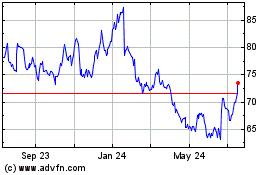IN THE PIPELINE: Gilead Looks To Extend HIV Lead With Drug Combo
July 26 2011 - 11:30AM
Dow Jones News
Gilead Sciences Inc. (GILD) dominates the HIV treatment market,
but it is working to continue that role with a once-a-day pill that
contains a four-drug treatment regimen.
The Foster City, Calif., drug maker's $7.4 billion in 2010
product sales mostly came from combination HIV treatments including
double-drug Truvada and triple-treatment Atripla, which is the only
single-pill full regimen for the disease. The four-drug pill in
development, commonly called the Quad, is expected to have
late-stage clinical data soon and Gilead plans to file for approval
in early 2012.
"It will be nice to have more options for initial therapy with a
one-pill-a-day regimen," said Eric Poeschla, an HIV physician and
professor at the Mayo Clinic in Rochester, Minn. He has no
connections to Gilead.
Having a combination of treatments in one pill is attractive
because it ensures that patients take all the drugs they need.
Adhering to a prescribed drug regiment is needed to maintain HIV
viral suppression. Increased viral load--the amount of virus in the
blood--in the presence of medications raises the chances that HIV
will mutate and become resistant to the drug.
Last year, UBS estimated that more than 70% of treated patients
in the U.S. are using either Atripla or Truvada. A Gilead
spokeswoman said Atripla, launched in 2006, "has fast become the
most-prescribed HIV treatment in the United States."
Aside from potentially benefiting patients, including possibly
cutting back on side effects, the Quad is also financially better
for Gilead because it owns all of the components; Atripla includes
a Bristol-Myer Squibb Co. (BMY) drug. Also, Wall Street analysts
expect the pill to allow for aggressive pricing, something that
further enhances the advantages to Gilead's profits.
HIV destroys immune system components called T-cells and the
later stage of the disease is called AIDS. The first cases of the
disease were diagnosed three decades ago with poor patient
prognosis, but antiviral drugs--used in combination to fight
resistance--have changed that in the developed world.
"HIV has gone from virtually a uniformly fatal illnes to a very
managable condition that is often compared, reasonably, to having
diabetes," Dr. Poeschla said. He noted that patients can still have
significant medical issues, need to take medicine every day and
need to be monitored by a doctor.
The Centers for Disease Control estimates that 1.1 million
people in the U.S. were living with HIV infection as of the end of
2006, with 21% of those undiagnosed. In that year, about 56,300
people were infected, the agency estimates.
The drugs that fight the disease, generally work by targeting
various processes that the virus uses to replicate.
The Quad pill in development is the double-drug Truvada, with
evitegravir, an integrase inhibitor--similar to Merck & Co.'s
(MRK) Isentress--that works by interfering with HIV's ability to
integrate into the genetic material of human cells.
The fourth portion of the drug is cobicistat, a so-called
boosting agent that increases the amount of evitegravir in the
blood, thus allowing once-daily dosing.
The Quad is being studied in two late-stage trials that are due
in the third quarter. One study tests its effectiveness versus
Atripla, while another compares it to Truvada combined with
Bristol-Myers Squibb's Reyataz, along with Norvir from Abbott
Laboratories (ABT).
Other than convenience, the Quad pill is hoped to have fewer
side effects than Atripla, which includes Bristol-Myers' Sustiva.
Sustiva can cause symptoms like dizziness, insomnia and impaired
concentration, and it can't be used by women of child-bearing
age.
Other than convenience, the Quad pill is hoped to have fewer
side effects related to Sustiva including central nervous system
symptoms such as dizziness, insomnia and impaired concentration.
Also, the elimination of Sustiva means that it could be taken by
women of child-bearing age.
Because of those benefits, the Quad may not have to show that it
works better than Atripla and could gain "significant adoption" if
it demonstrated similar effectiveness, Oppenheimer & Co.
analyst Bret Holley said recently in a note to clients.
Aside from the Quad, Gilead is seeking approval of a follow-up
to Atripla, commonly called "B-tripla," that is a combination of
Truvada and TMC278, an antiviral drug from Johnson & Johnson
(JNJ). A decision from the Food and Drug Administration is expected
in August.
-By Thomas Gryta, Dow Jones Newswires; 212-416-2169;
thomas.gryta@dowjones.com
Gilead Sciences (NASDAQ:GILD)
Historical Stock Chart
From May 2024 to Jun 2024

Gilead Sciences (NASDAQ:GILD)
Historical Stock Chart
From Jun 2023 to Jun 2024
